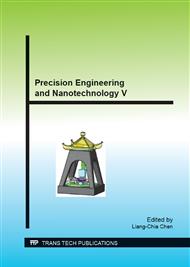p.446
p.453
p.458
p.463
p.469
p.475
p.483
p.489
p.496
Study on the Key Parameters in Etching of Fused Silica Using Atmospheric Inductively Coupled Plasma
Abstract:
Atmospheric Pressure Plasma Processing (APPP) of silicon-based optics and wafers is a form of chemical etching technology developed in recent years. The material removal rate is comparable to those of conventional mechanical processing methods in precision fabrication. Moreover, there is no mechanical contact or physical loading on the substrate surface, hence no surface or sub-surface damages are induced. Inductively coupled plasma is one realization of APPP. In this work, inductively coupled plasma torch is used to generate plasma and excite etchant particles at atmospheric pressure. These active particles then diffused to the workpiece surface, react with its atoms to form volatile products. The activity and number of particles in plasma are influenced by processing parameters such as input power, distance between nozzle and substrate surface, flow rate of plasma gas argon and precursor gas CF4. These factors have various impacts on material removal rate. Processing experiments are conducted on fused silica to investigate the parameters’ influences on material removal rate. The basic interaction between substrate surface and plasma is illustrated, then the relationships between processing parameters and material removal rate are analyzed. From the experiments some trends are derived. Material removal rate rises with the increase of power and flow rate of CF4, whereas decreases with the increase of processing distance, etc. The etching footprint is proved to be near Gaussian-shaped and believed to have high potential for deterministic surface processing.
Info:
Periodical:
Pages:
469-474
Citation:
Online since:
August 2014
Price:
Сopyright:
© 2015 Trans Tech Publications Ltd. All Rights Reserved
Share:
Citation:


